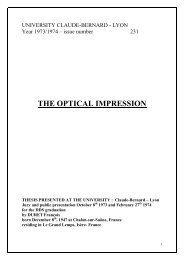english version(pg40to78) - Pr. François Duret
english version(pg40to78) - Pr. François Duret
english version(pg40to78) - Pr. François Duret
You also want an ePaper? Increase the reach of your titles
YUMPU automatically turns print PDFs into web optimized ePapers that Google loves.
F <strong>Duret</strong> and Coll. <strong>Pr</strong>incipes de fonctionnement et applications techniques de l’empreinte optique dans l’exercice de cabinet<br />
(traduction Anglaise)<br />
Page 98<br />
♦ Working laterality, we can choose to establish either a canine<br />
function or a group function depending on the clinical<br />
conditions.<br />
♦ Non working laterality: there must be no occlusal interference.<br />
These criteria are in the program’s memory for all prosthetic<br />
treatments.<br />
Whether we’re realising a small reconstruction (crown, fixed bridge)<br />
or a great reconstruction, we can envisage an elaboration technique for<br />
the prosthesis:<br />
- either with usual occlusion, position 2 of Posselt’s diagram<br />
- either with central relationship occlusion, position 1 of Posselt’s<br />
diagram<br />
- or between position 1 and 2 of the diagram with the “central<br />
freedom” technique (SCHUYLER, RAMFJORD or DAWSON).<br />
The flexibility of the system’s realisation is optimised by the fact that<br />
each starting element is taken into account, memorised and used<br />
according to the specific needs of each envisaged reconstruction case<br />
and according to the practioner’s own tendencies.<br />
This handling finesse, in a very short time (less than 3nm), enables the<br />
smoothing of the occlusal surface of the prosthetic tooth while<br />
respecting the blocked or freed central ones and any varying of the<br />
structure up to the fusion of positions 1 and 2 of Posselt’s diagram.<br />
CONTROL<br />
The practioner will have to control the aesthetics of his prosthesis with<br />
regards to the neighbouring teeth and following the incidence he will<br />
select. Thus, an anterior tooth will be visualised following a frontal<br />
plan when a pre molar or a molar will be studied according to a 10 to<br />
20° view with regards to the median sagittal plan 27 .<br />
This operation mode will enable eventual aesthetic corrections. This<br />
action, very important, will be specific to each practioner and will lead<br />
inevitably to a new personalisation of the work (reversible action). It<br />
can be considered as an artistic action potentiated by artificial<br />
intelligence. It seems to demonstrate that the CAD/CAM set is a<br />
Les Cahiers de <strong>Pr</strong>othèse (50) pp 73 – 110, 1985



